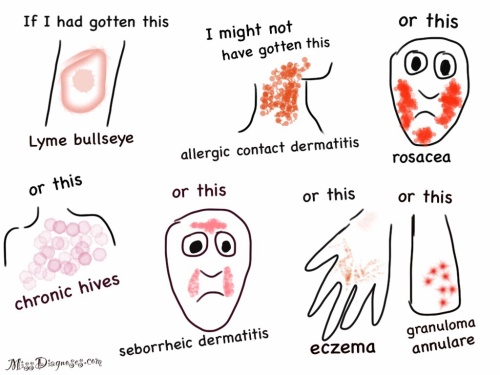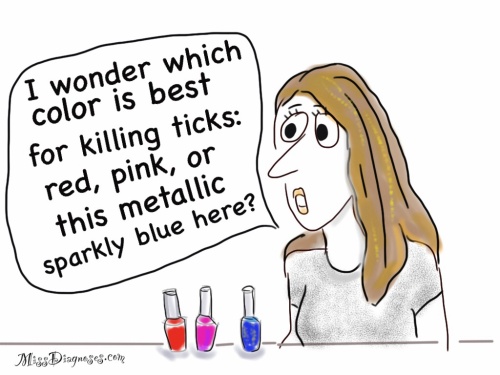Hello! It’s not only Lyme Awareness Month but also Fibromyalgia Awareness Month, Food Allergy Awareness Month, Multiple Chemical Sensitivities (MCS) Awareness Month, Myalgic Encephalomyelitis (ME) Awareness Month, and Asthma Awareness Month. OK, so I think fibromyalgia, ME, and MCS technically only have an awareness DAY, which is today, May 12, and that’s not fair. Still, I have a few of these conditions, and so I am wondering who decided to make May the awareness month for ALL OF THEM. Severe fatigue is a symptom for most of the conditions, so couldn’t awareness days and months be distributed more evenly throughout the year? So we can, you know, rest?
Anyway, in honor of Lyme Awareness Month, I bring you:
Some Lyme Myths
1. Myth: You have to be “outdoorsy” or like hiking to get Lyme disease. My family keeps asking me why I got it, since I am not “outdoorsy.” I am “indoorsy.” I love trees, but I’m pretty much a city person.
Obviously, it’s easier to get Lyme in a woodsy area with deer or in a place with a lot of brush or tall grass (ticks love tall grass), but people also get it in urban environments: for example, while gardening, walking through parks (300 ticks were found in one square meter of a British park), or through contact with pets who have been outdoors and picked up infected ticks. Ticks also like piles of leaves and woodpiles in yards.
I LOVE dogs, and there are tons of cute dogs in my neighborhood. I used to pet as many of them as possible for as long as possible. Maybe that was a bad idea?
2. Myth: Everyone with Lyme gets a bullseye rash.
Fewer than 50 percent of Lyme patients get a bullseye rash. You would think, given my lengthy list of skin woes, that I would have gotten the bullseye rash, but no. Lyme is hard to diagnose, and the bullseye rash is considered one hundred percent diagnostic. You don’t even need to get a blood test if you have the rash. It’s one of the few rashes that’s actually useful. And it tends to disappear within a reasonable time frame (unlike everything else I have). I think most of my chronic skin conditions (especially the skin allergies) may have been created or worsened by years of undiagnosed Lyme.

Seriously—my skin was pretty clear until a year after the time when I think I got the Lyme. And then it went nuts.
3. Myth: You will remember a tick bite.
Fewer than fifty percent of people remember a tick bite. I don’t. Nymph ticks (the stage between larvae and adult) transmit a lot of Lyme. They’re about the size of poppy seeds, and their bite is painless. Adult ticks also transmit Lyme, but they’re bigger and easier to notice on your body.
4. Myth: If your doctor gives you a Lyme ELISA screening test and it’s negative, you don’t have Lyme.
If your doctor offers to test you with an ELISA test, save your money. This test has a 30–65 percent accuracy rate, depending on the lab. If you have been diagnosed with fibromyalgia, ME, rheumatoid arthritis, multiple sclerosis, or any of the other conditions Lyme commonly mimics, it’s a good idea to get a reputable Lyme test, such as an IGeneX Western blot, from a Lyme-literate doctor. The IGeneX test is much more specific than standard lab tests (there are over one hundred strains of Lyme in the U.S.), and has been verified by the U.S. Department of Medicare and Medicaid Services.
I was misdiagnosed for five years. Lyme is much easier to eradicate if you catch it early.
5. Myth: Lyme only exists in the northeastern United States. Lyme has been found everywhere in the United States, although some areas, especially the Northeast, are much worse than others (see map). Lyme is also in Canada, Europe, China, Australia, etc. The only continent where it has never been found is Antarctica.
6. Myth: One month of antibiotics will cure Lyme.
There are many studies that show the one-month treatment is inadequate. It does not take into account the length of time the person was infected. In addition, the Lyme bacteria, called the “spirochete” because of its spiral shape, is very hard to kill. The shape allows the spirochete to burrow into joints, cartilage, and other types of tissue, and the bacteria can change their surface proteins and morph into several different forms in order to hide from the immune system. As if that weren’t bad enough, Lyme can also suppress immune system function by reducing the number of certain types of white blood cells. Short treatment courses result in a relapse rate of more than forty percent. The Infectious Diseases Society of America likes to call this “Post-Lyme-Syndrome,” but isn’t it really “Still-Has-Lyme-Syndrome”?
7. Myth: If you get bitten by a tick, you should cover the tick with nail polish.
I could not make this up! I saw it on Facebook, in a thread of equally uninformed people. I was curious as to how that would work:

This is the proper way to remove a tick:
1. Use tweezers or forceps.
2. Grasp the tick at its mouthparts, close to the skin.
3. Don’t squeeze the tick, because squeezing might spread the tick’s infected body fluids.
4. Pull the tick straight out. Don’t twist.
5. You may understandably be tempted to throw the tick away or burn it, but you can save yourself a lot of trouble by saving it and having it tested for Lyme and other tick-borne infections by a specialized lab. Not all ticks, even in Lyme-endemic areas, are infected.
Fellow Lymies, if I have forgotten anything, please feel free to mention it in the comments section. And please check out this parodic “Lyme rap” video, the “Chronicles of Borrelia” by MC Herx (for non-Lyme people, “Borrelia burgdorferi” is the name of the Lyme bacteria, and a “herx” is the bad reaction you can get when you take medicine and too many bacteria die off at once, leaving an overload of toxins in the body).





Great post! So glad you were able to put this all together :). You include all the common Lyme myths which are really important for EVERYONE to understand!
LikeLiked by 1 person
Thank you! I worried that I missed a few. My big fear is being bitten AGAIN … The people who are bitten several times seem to have the worst symptoms. Aargh.
LikeLike
Reblogged this on Seriously "Sensitive" to Pollution and commented:
Are you Lyme Aware?
More than a few of my online friends developed MCS/ES in addition to Lyme Disease.
Miss D exposes a few common myths…
LikeLiked by 1 person
Hoping so much that you can find the right treatments you need for healing
LikeLiked by 1 person
Thank you for that and thanks for reblogging! Yeah, ha, me too! It is a problem when there is so much controversy about treatments.
LikeLike
Maybe once the diagnostic testing methods are “fixed”, then treatment methods will be taken more seriously too.
I have to wonder what kind of industry interference is at play in all of this, as there is always some whenever there are medical controversies.
The controversies cease to exist only when industry figures out a way to profit from people’s illness and disease.
Or when so many people are affected that the 100th Monkey effect takes place (if that’s the right way of saying it) and the truth becomes self-evident and can no longer be distorted.
Here’s to more healing times!
LikeLiked by 1 person
The CDC’s testing methods are the problem … they are too restrictive and don’t include enough bands. Also the CDC took two important diagnostic bands (the bands represent antibodies) out of the criteria for Lyme diagnosis because they were using them to make a vaccine. The vaccine didn’t work but those bands are still not included. The CDC messed up the guidelines for testing and treatment and a lot of people go undiagnosed as a result. Also a lot of doctors who treat chronic Lyme with long-term antibiotics get sued — it’s just a mess.
LikeLike
There’s a lot of industry control and interference at the CDC whenever it comes to environmentally linked health conditions.
We have to get corporations out… they have too much power now, and their only motivation is profit, regardless of the costs or long term effects.
Until corporate power is reduced, progress with all life supporting and enhancing matters is difficult…
LikeLiked by 1 person
Good information. My dogs seems to collect those little tick buddies and then bring them in the house and share them with us. Awareness means we find ticks crawling around rather than biting.
LikeLiked by 1 person
Oh wow, scary! This blog has some links on how to check the dog for ticks and some reviews of various products to remove ticks. Not all ticks have it, but you can’t be too careful. http://aftergadget.wordpress.com/2012/05/25/product-review-tick-removal-forceps/
LikeLike
Thanks. I used to really freak out when I saw a tick but now I just check for them and drown those little guys when I find them. Thanks for the link.
LikeLiked by 1 person
Ha, I can believe it. I have read a bunch of stuff about unsavory goings-on at the CDC, but I can’t remember what I read now. Boo! Brain fog.
LikeLike
Hi! I realized I hadn’t stopped by your blog to tell you how much I love this post. As I may have mentioned before, you definitely are one of my most favorite bloggers. I learn so much from you and LOVE your writing & cartoons…the dog one is the best! Xoxo
LikeLiked by 1 person
My ZenT! Yay! Thank you! I miss randomly petting every dog without wondering about tick collars, doing tick checks, etc.
LikeLike
My beautiful Max is completely tick-free so WHEN you meet him, you can snuggle away.
LikeLiked by 1 person
Yayyyyy! I will be so happy to meet you and your puppy! (I call all dogs puppies, even if they are 16 … LOL.)
LikeLike